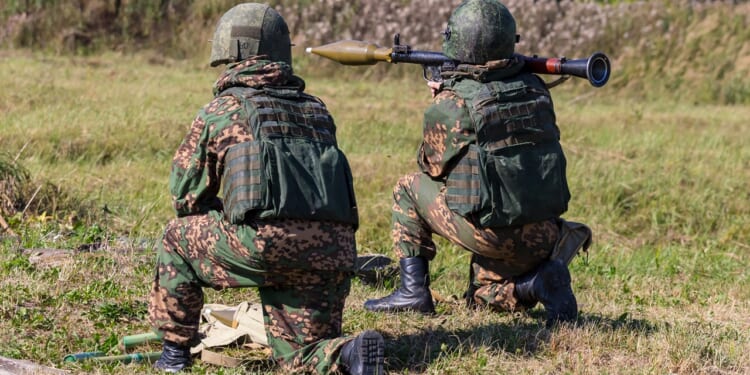The RPG-7 has profoundly shaped asymmetric and conventional warfare by democratizing anti-armor capabilities.
Tracing its origins back to the immediate end of the Second World War, the Soviet Union’s RPG-7 is one of the most iconic weapons in the world. Based on captured German Panzerfaust and American Bazooka designs, the RPG was a revolutionary invention. The earlier RPG-2 was introduced in the 1940s, but it was outperformed by the intermediate RPG-4 during testing. In turn, the success of the RPG-4 led to the creation of the RPG-7 in 1958. Since that time, over 9 million units have been produced—and used in conflicts across more than 80 countries.
What to Know About the RPG’s Development
Development on the RPG-7—Ruchnoy Protivotankovy Granatomyot, or “Hand-Held Antitank Grenade Launcher,” later backronymmed in English as “Rocket-Propelled Grenade”—began in 1958. The weapon was formally adopted by the Red Army in 1961, replacing the RPG-2 at the squad level. Moscow also supplied many thousands of the weapons to communist movements throughout the world, and the RPG-7 saw early combat use during the Vietnam War by Soviet-backed North Vietnamese forces around 1967-68. In the years since, it has been exported, licensed, or copied by numerous countries, including Vietnam, Iran, and Azerbaijan.
Initially, the Soviet state-owned enterprise Bazalt, formerly known as the Scientific Research Institute-1, handled the production of the RPG-7, with manufacturing of the legendary weapon occurring at the Degtyarev plant in Kovrov, Russia. After the dissolution of the Soviet Union, the Scientific Research Institute-1 became Bazalt and continued manufacturing the weapon.
Primarily designed as an anti-tank weapon for infantry squads to engage armored vehicles at close-to-medium ranges, this simple, low cost, and rugged weapon makes it ideal for both conventional armies and irregular forces. Over time, the RPG-7 has been adapted for anti-personnel roles, urban warfare, and even anti-aircraft use against low-flying helicopters or drones.
The RPG-7’s Specifications
The RPG-7 is a muzzle-loaded launcher with a 40mm caliber steel tube. It is 950mm (37.4 inches) long, wrapped in wood for heat protection. and featuring a flared rear end to reduce backblast.
The launcher weighs 13.9 pounds unloaded, and about a pound heavier with the PGO-7 optical sight. The weapon operates via a two-stage propulsion system: an initial gunpowder booster charge launches the grenade at 380 feet per second, followed by a rocket motor that ignites after about 33 feet to reach a maximum velocity of 968 feet per second. This creates a visible smoke trail, which can reveal the shooter’s position.
- Effective firing range: Up to 1,080 feet for anti-tank rounds like the PG-7; maximum range around 3,020 feet before self-detonation (for safety).
- Sights/Accessories: Iron sights standard; optional sights like PGO-7V (a 2.7x magnification) for improved accuracy; later models include bipods and universal sights for various rounds.
- Variants: Include paratrooper models (RPG-7D with detachable barrel) and night-sight versions (RPG-7N), for example.
There are a variety of warheads that offer differing capabilities, depending on the need of the mission.
- The PG-7 is an 85mm shaped-charge high-explosive anti-tank (HEAT) warhead; capable of penetrating 260mm of rolled homogenous armor (RHA).
- PG-7VL which is a 93mm HEAT round that penetrates of 500 mm RHA. Then there’s the PG-7VR, first fielded in 1988, which is a tandem-charge HEAT round, penetrating 60mm RHA with explosive reactive armor (ERA) or 900mm without.
- The TBG-7V is a 105mmm thermobaric warhead for anti-personnel and structures.
- The OG-7V came out in 1999 and is a 40mm fragmentation warhead for anti-infantry mission sets, with no sustainer motor.
Other modern variants include the GSh-7VT anti-bunker round. As of 2023, there are even adaptations for firing 82mm mines. For best results, operators have found that two-men teams consisting of one person to fire and a loader to carry the ammunition and assist with targeting are key.
The RPG-7 has profoundly shaped asymmetric and conventional warfare by democratizing anti-armor capabilities, allowing lightly equipped forces to challenge heavily armored opponents. During the Battle of Mogadishu on October 3, 1993, Somali militiamen loyal to warlord Mohamed Farrah Aidid, alongside at least 10 member of Al-Qaeda, used RPG-7s to down two US Army MH-60 Black Hawk helicopters. The Battle of Mogadishu proved the RPG-7’s effectiveness against low-flying aircraft in dense urban environments.
Often costing under $500 per launcher, the RPG-7’s low cost, coupled with its proven track record across global battlefields, as well as its portability, make it ideal for insurgents and militaries that are cash-stripped and resource-starved. RPG-7s excel against lightly armored vehicles, infantry, fortifications, and even drones or helicopters. Upgraded warheads like tandem-charge variants can still penetrate older tanks or those without protections, and it’s actively used in ongoing wars, like Ukraine and Syria.
RPGs Aren’t Very Useful Against Modern Tanks
Against cutting-edge main battle tanks (MBTs) that are equipped with explosive reactive armor (ERA) and other advanced accoutrements, the RPG-7 is less effective and often requires multiple hits or flanking tactics. Thus, after more than half-a-century of service, the RPG-7 might finally (slowly) be made obsolete.
Regardless of this new reality, the RPG-7 has made an outsized mark in the annals of modern warfare. It is unlikely to be surpassed by whatever replaces it anytime soon.
About the Author: Brandon J. Weichert
Brandon J. Weichert is a senior national security editor at The National Interest. Recently, Weichert became the host of The National Security Hour on America Outloud News and iHeartRadio, where he discusses national security policy every Wednesday at 8pm Eastern. He is also a contributor at Popular Mechanics and has consulted regularly with various government institutions and private organizations on geopolitical issues. Weichert’s writings have appeared in multiple publications, including The Washington Times, National Review, The American Spectator, MSN, The Asia Times, and others. His books include Winning Space: How America Remains a Superpower, Biohacked: China’s Race to Control Life, and The Shadow War: Iran’s Quest for Supremacy. His newest book, A Disaster of Our Own Making: How the West Lost Ukraine is available for purchase wherever books are sold. He can be followed via Twitter @WeTheBrandon.
Image: Shutterstock / NCKAHDEP.


















